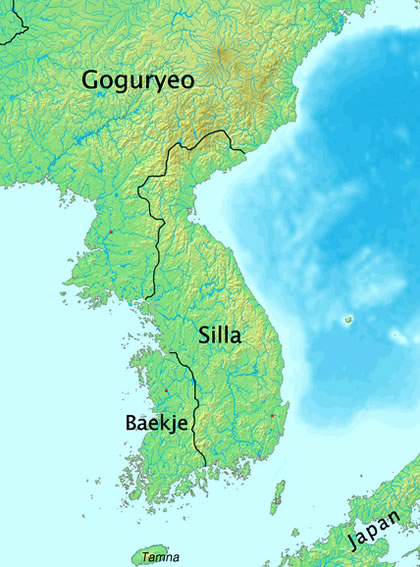 |
| Silla Dynasty Map |
The Silla dynasty was a Korean kingdom with origins in the southeast of the country, in the area around modernday Pusan (Busan). It is said to have begun in about 57 b.c.e. when the Saro tribe and its allies in that region established a confederation of the tribes, led by Pak Hyeokgeose.
However many historians feel that date was the invention of 12th-century Korean historians, as found in the Samguk Sagi, written by Kim Bu-sik, to try to show that the Silla predated their main rivals. The early years of Silla saw a rotated monarchy with members of the Pak, Kim, and Sok families sharing the title of ruler, although not using the title of king until later.
As the kingdom of Koguryo was emerging as a major power in northern and central Korea, Silla was taking over tribes in the south. Originally they only targeted the Saro tribe, taking tribute to the Mahan confederation as their vassal in 19 b.c.e.
  |
However Silla grew dramatically in prosperity and many historians have seen this as the influence of many Chinese merchants who came to settle in the area and brought with them much resultant trade.
There were also influences from Japan—the envoy that took the tribute to Mahan in 19 b.c.e. was of Japanese ancestry. In the year after this mission, the king of Mahan died and although Silla sent over a delegation for the funeral, they rapidly drew up plans to take land from Mahan and enlarge their area.
 |
| Silla dynasty artifact |
In 250 c.e. the Mahan confederacy, which had controlled much of central southern Korea, was finally absorbed, not by Silla, but by the kingdom of Paekche (Baekje), which had a common border with Silla.
This was initially thought to be dangerous as it left the Korean Peninsula under the control of three kingdoms, Silla, Paekche, and Koguryo, with little in the way of buffer states that had existed beforehand. Silla and Paekche feared invasion from the emerging power of Koguryo, which had ejected the last Chinese base in 313.
To counter this threat, Kim Naemul (356–401) of Silla assumed the title of maripkan or king ensured that the succession to the throne was hereditary. The end of the rotating monarchy resulted in the ability to establish a more centralized administration, which adopted many of their methods of government, customs, and some Chinese culture.
   |
Initially Silla sided with Koguryo to attack Paekche, which had been aiding Japanese pirates. However when Koguryo moved its capital south to Pyongyang in 427, and its focus also moved south, Koguryo and Silla had to form an alliance. Silla also built up trade ties with Japan.
King Peopheung (r. 514–540) established Buddhism as the state religion of the kingdom of Silla and embarked on military expeditions that eroded the power of the nonaligned tribes in the region.
 |
| Silla dynasty crown |
His successor, King Jinheung (r. 540–576), enlarged the army and used it to help Paekche take lands around modern-day Seoul. However in 553 he decided that his forces were strong enough to seize the whole area for itself, ending the 120-year alliance of convenience between Silla and Paekche.
The war in 553–555 led to Silla’s massively enlarging its landholdings, with Paekche forced to cede over half of its territory. This was followed by a long period of peace when scholars in Silla devoted much time to Buddhism.
King Pak-jong, who ascended the throne in 576, abdicated to become a monk and his wife became a nun. A considerable part of the wealth of the country was sent in missions of tribute to China, which weakened Silla economically but bought them a firm alliance.